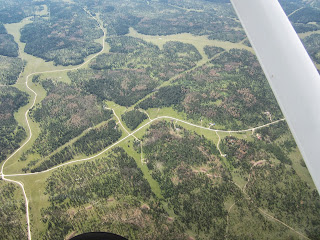In the plane I called to pick up my clearance. The controller said that he could give it to me a clearance and release at the same time, so call back when I was ready to take off. So we taxied out to the east end of the runway, did our run-up, and called for our clearance. But from there the controller was not responding. After repeated calls I decided to take off and pick up my clearance in the air. As soon as we were off, I called the controller and he cleared us to climb to 13,000 feet. Yikes, that is a long way up for my little airplane. It will do it, but regulations say I cannot stay that high more than 30 minutes without supplemental oxygen.
I negotiate with the controller.
 |
| IFR Low Altitude chart for western Montana |
We were churning along at 10,000 feet and the winds across the Rockies were starting to pick up. Our little plane was being bounced around. So I thought I could compromise with the controller at 12,000. I called requesting 12,000.
On a weak and garbled transmitter a new controller replied.
I read back my clearance "One eight tree (we say 'tree' instead of 'three') five zulu, cleared to climb out of one zero thousand for one two thousand" and began to climb. At 10,000 feet, I don’t have much climb performance, so about two minutes later as I was just clearing 10,700 feet.
A new voice on the radio came on with some urgency, "Seattle Center, One eight tree five zulu return immediately to one zero thousand feet."
OK, back down to 10,000.
A few minutes later I received "Cleared to one two thousand. And when you get on the ground, I have a number for you to call."
Uh oh. That’s not good. That usually means they want to reprimand you. I wonder what I did.
Victor two is a straight line between Helena and Missoula. The MOCA along that route is 10,300 feet, and again I had an odd exchange with the controller.
"Can you accept direct to Missoula?"
Sure, since that is what victor two's path is.
"Cleared direct Missoula at one zero thousand feet."
Now that is just weird. Earlier I was cleared on a 10,800 ft MOCA down to 10,000 and now again on a 10,300 ft MOCA down to 10,000. I'm not worried because it is clear and I can see everything around me. I have no concerns for colliding with the Rockies. On a side note, the National Transportation Safety Board (NTSB) investigates and categorizes accidents. They would call colliding with Rockies "CFIT" (pronounced see-fit), or Controlled Flight Into Terrain.
What did concern me was the call I had to make in Spokane. We landed at Spokane International after our new longest leg of 2:56. The runways and taxiways are all torn up there for construction, so I got progressive taxi instructions to parking. We spilled out and I went inside to make the call. I reviewed all my charts, and played back the earlier diversion and negotiations over MEA and MOCA.
I steeled my nerve and dialed the number. "This line is recorded." Well that’s a fine "How do you do."
The same urgent voice that had earlier sent me back to 10,000 feet answered. "Thanks for calling, I listened to the tape. You did not get the clearance you thought to climb to 12,000. But since you read back what you thought your clearance was, we should have stopped you. You did it right. Sorry for the trouble, have a nice day."
And with that I let out a big sigh of relief. We exchanged pleasantries and hung up.
It was time for a meal. Again we are loaned a crew car and we head over to Airway Heights to find food.
 |
| Departure instructions for Spokane airport |
My clearance brought me up to 10,000 feet again, well above the terrain. Along this stretch 10,000 also put us above the thermal turbulence and heat. Our path took us over Moses Lake, then to Ellensburg.
Crossing the Ellensburg VOR and approaching the eastern slope of the Cascade Range, a thin layer of clouds developed above us. My passengers in the back seat were sleeping soundly. In the front seats Isaac and I watched as the plane flitted in and out of the base of the clouds. The clouds sloped down, so as we progressed further into the Cascade Range we got further clouds, and soon we were skittering along the top of the thin fluffy layer. The tops of the clouds formed cloud-valleys and cloud-tunnels as we raced through them. It was very pretty. Isaac and I marveled at the clouds as we bounced from one to the next.
We stayed at 10,000 until well onto the west side of the mountains, still skipping along in and out of the clouds. We were then cleared turn direct to Paine Field and to descend, first to 8,000, then 6,000, then 4,000. We broke out of the clouds somewhere below 6,000. Upon reporting the airport in sight, we were cleared for the visual approach and handed off to the tower controllers. The plane touched down 2:05 after leaving Spokane.
During the week I had flown over 14 hours on IFR flight plans, logged an hour of actual instrument flight, and made exactly zero instrument approaches.










